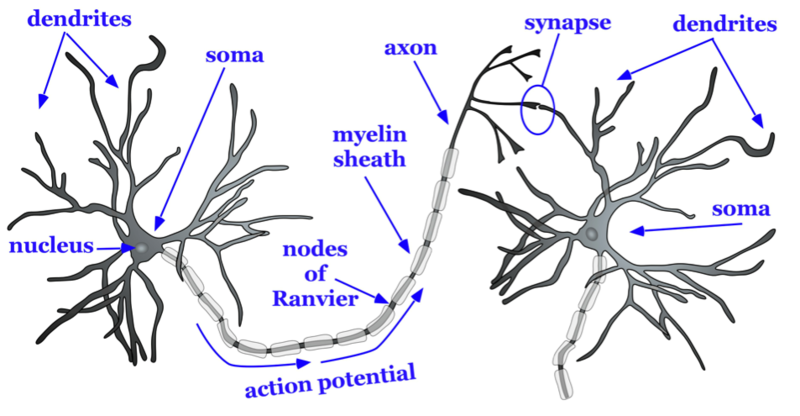Neuron
I first learned about neurons when I was building Neural Networks. Also in my science class. But finally studying this a bit more formally from a biological perspective in PSYCH101.
https://nobaproject.com/textbooks/paul-wehr-new-textbook/modules/neurons#basic-nomenclature
there is so much content about the brain… I am not a neuroscientist. Will learn this later.
Structure of the Neuron
There are approximately 100 billion neurons in the human brain.
Each neuron has three main components:
- Dendrites
- receive information from thousands of other neurons and are the main source of input of the neuron
- Soma
- Cell body of a neuron that contains the nucleus and genetic information, and directs protein synthesis.
- Axon
- the main source of output of the neuron
Other terminology: - Synapse: Junction between the presynaptic terminal button of one neuron and the dendrite, axon, or soma of another postsynaptic neuron.
- Myelin sheath: Substance around the axon of a neuron that serves as insulation to allow the Action Potential to conduct rapidly toward the terminal buttons.

Types of Neurons
There are three main categories of neurons, each defined by its specific structure. The structures of these three different types of neurons support their unique functions.
- Unipolar neurons are structured in such a way that is ideal for relaying information forward, so they have one neurite (axon) and no dendrites. They are involved in transmission of physiological information from the body’s periphery such as communicating body temperature through the spinal cord up to the brain.
- Bipolar neurons are involved in sensory perception such as perception of light in the retina of the eye. They have one axon and one dendrite which help acquire and pass sensory information to various centers in the brain.
- multipolar neurons are the most common and they communicate sensory and motor information in the brain. For example, their firing causes muscles in the body to contract. Multipolar neurons have one axon and many dendrites which allows them to communicate with other neurons. One of the most prominent neurons is a pyramidal neuron, which falls under the multipolar category. It gets its name from the triangular or pyramidal shape of its soma (for examples see, Furtak, Moyer, & Brown, 2007).
Communication between Neurons
There are 2 stages:
- Electrical conduction of dendritic input to the initiation of an action potential within a neuron
- Chemical transmission across the synaptic gap between the presynaptic neuron and the postsynaptic neuron of the synapse.